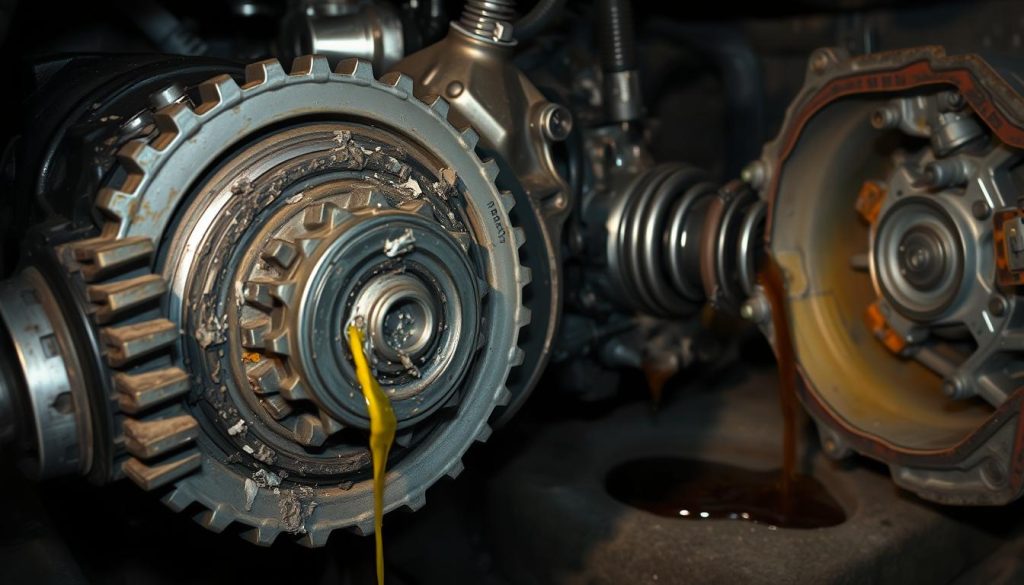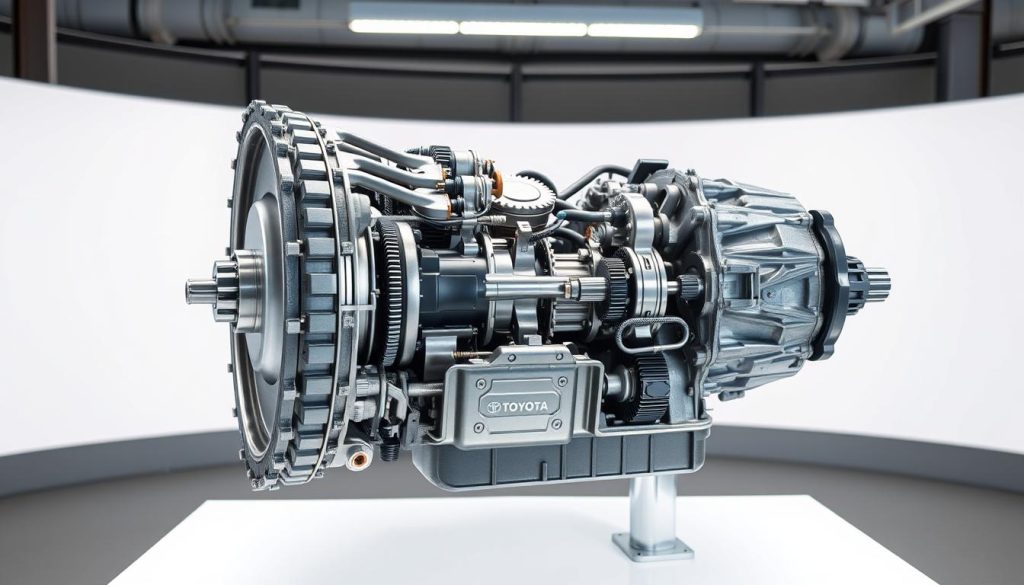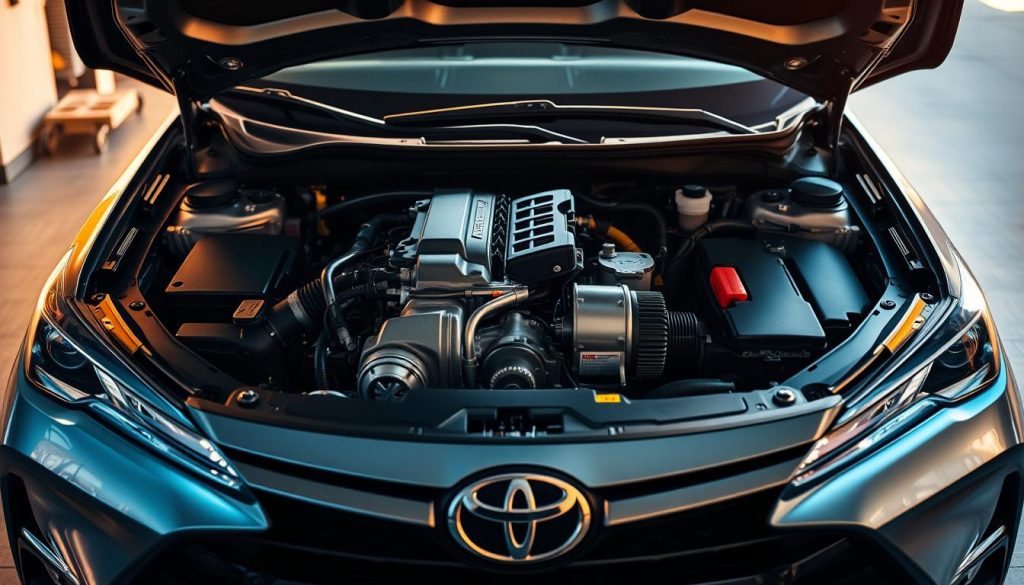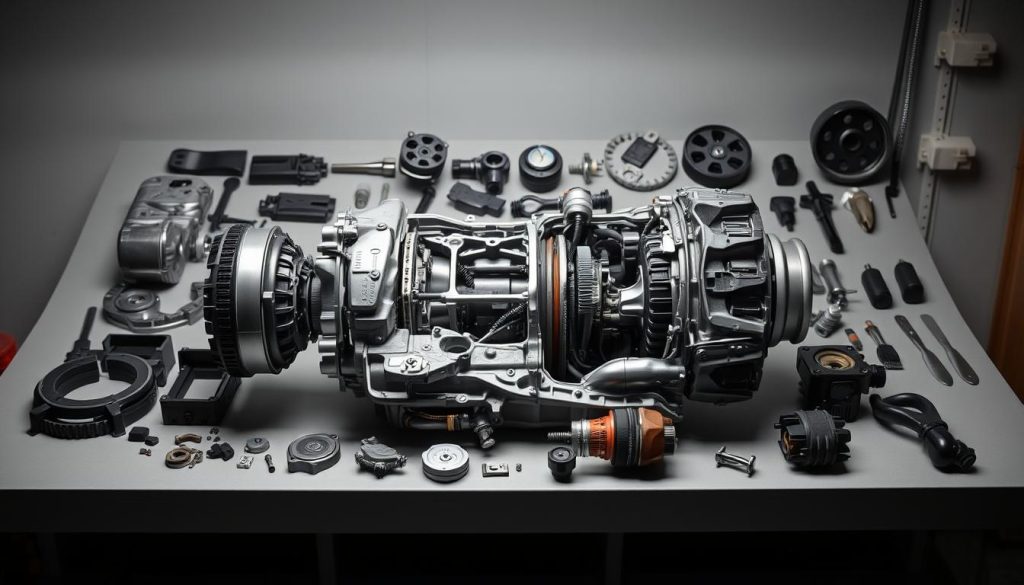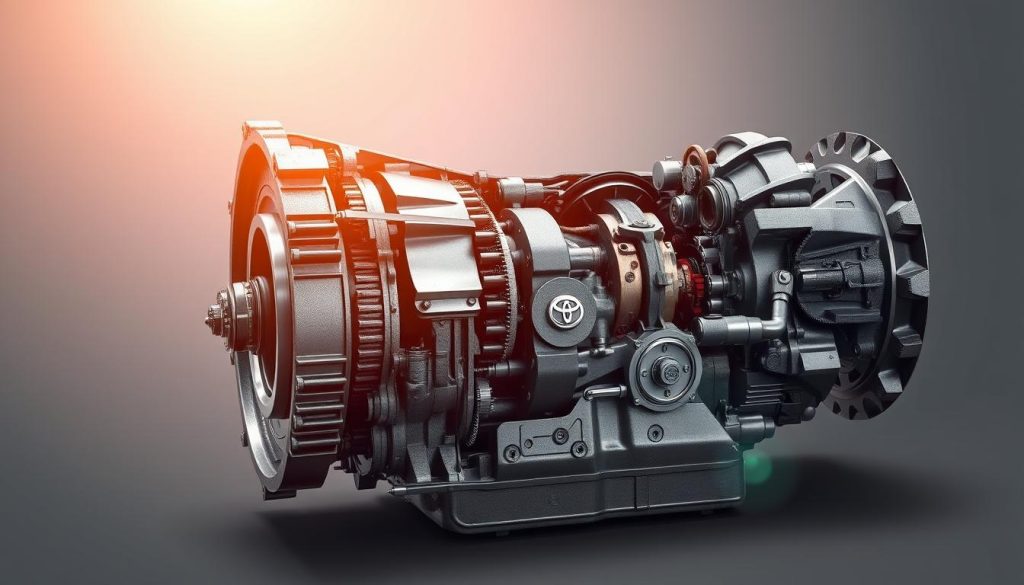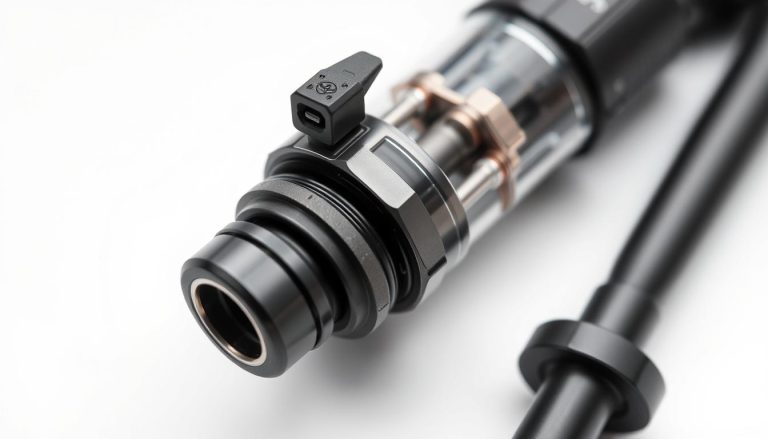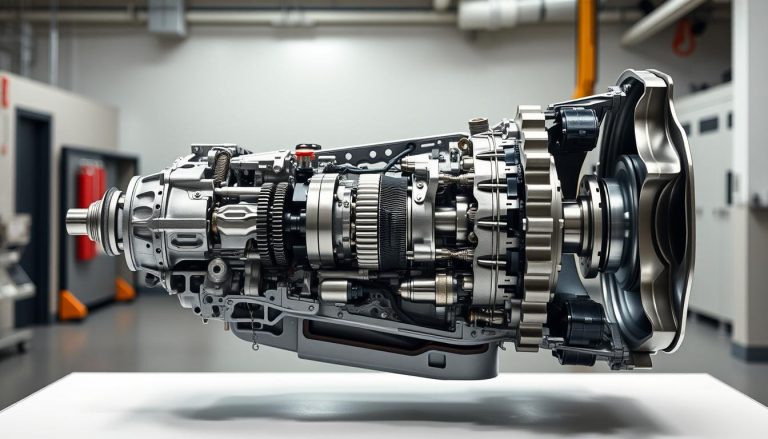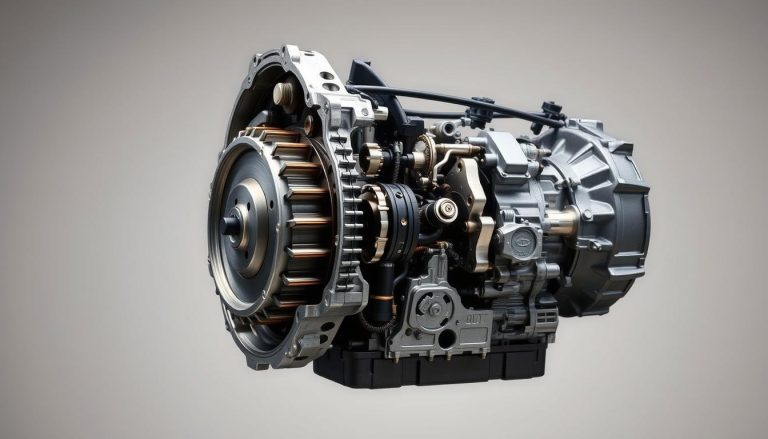Resolve Common Toyota Transmission Issues
The transmission is key to your Toyota’s function. It connects the engine to the wheels, making sure your car moves smoothly. Even with Toyota’s good name, sometimes transmissions can go wrong. Fixing these problems quickly is vital to avoid bigger issues.
Knowing how to tackle Toyota transmission troubles can save you a lot. It keeps your car running well for longer. Spotting and fixing these issues early is key to keeping your Toyota in top shape.
Introduction to Toyota Transmission Problems
Toyota cars are known for being reliable and efficient. Yet, they can face transmission problems like any other car. Catching common transmission issues early can save time and money. It also makes driving smoother.
Toyota transmission problems often show up as delayed gear shifts, slipping gears, or odd noises. Spotting these signs early can stop small problems from getting bigger. Keeping up with maintenance and knowing the warning signs is key to keeping your car running well.
Some common transmission issues you can fix yourself, but others need a pro. So, learning about your car’s transmission is very important for Toyota owners.
Signs of Transmission Problems in Toyotas
Spotting signs of transmission problems early can save you from big issues. Look out for signs that your Toyota’s transmission might be in trouble.
Delayed Gear Engagement
Delayed gear engagement is a clear sign of trouble. When you shift into gear, it should happen right away. If your car hesitates before moving, it’s a warning.
Slipping Gears
Slipping gears mean your car shifts unexpectedly. This can make driving unsafe and is a sign of serious problems. It’s important to get this checked out fast.
Unusual Noises
Strange noises like whining or clunking are bad signs. These sounds happen when shifting gears or in neutral. Catching these early can stop bigger problems later.
Causes of Transmission Issues in Toyota Vehicles
Transmission problems in Toyota vehicles can happen for many reasons. It’s important to catch these issues early to avoid bigger problems. Let’s look at some common areas where these issues often occur.
Low or Dirty Transmission Fluid
Transmission fluid is key to your Toyota’s smooth running. If it’s low or dirty, it can’t do its job well. This can cause your transmission to overheat and lead to more problems. Always check and change your transmission fluid regularly to keep your car running right.
Worn Clutch Components
In manual Toyotas, worn-out clutch parts are a big problem. Clutches get worn down and can’t work right anymore. This can make shifting gears hard and cause slipping, affecting your drive.
Faulty Sensors
Modern Toyotas use many sensors to talk to the transmission control unit (TCU). If these sensors go bad, the TCU gets confused. This can cause shifting problems and poor performance. Fixing or replacing bad sensors quickly can help keep your car running smoothly.
Mechanical Wear
As cars get older, they naturally wear out. Parts like gears and bearings can break down over time. Regular check-ups and catching wear early can help avoid costly repairs later on.
Troubleshooting Toyota Transmission Problems
Fixing Toyota transmission problems starts with spotting symptoms and doing detailed checks. A step-by-step method helps find the main causes of Toyota transmission issues quickly.
First, check the transmission fluid levels. Low or dirty fluid often causes problems. Always use the right fluid for your Toyota to prevent more issues.
If the fluid is okay, use diagnostic tools next. Modern Toyotas have onboard diagnostic systems (OBD-II) that find specific Toyota transmission issues. These tools show error codes that point to problems like faulty sensors or electronic control issues.
Don’t forget mechanical inspections. Look at clutches, gears, and bands for wear. Catching small problems early can prevent bigger ones later.
- Check Transmission Fluid: Make sure it’s at the right level and clean.
- Perform Diagnostic Scans: Use OBD-II tools to find error codes.
- Inspect Mechanical Parts: Regularly check for worn-out or damaged parts.
By doing detailed diagnostics and fixing the specific problems, you can fix Toyota transmission issues. This will also improve your car’s performance.
DIY Fixes for Minor Transmission Issues
Fixing minor transmission problems in your Toyota is simpler than you might think. With the right steps, some issues can be solved easily at home. Doing these DIY fixes can keep your car running well between visits to the mechanic.
Check Transmission Fluid Levels
It’s important to keep the transmission fluid at the right level. Low fluid can cause your car to shift poorly. Use the dipstick to check the fluid level often and add more if needed. This simple step can stop bigger problems later.
Inspect the Fluid Condition
Check the fluid’s color and clarity too. Good fluid is bright red and clean. If it smells burnt or looks dirty, it’s time for a change. New fluid helps your transmission work better and avoids expensive repairs.
Reset the Transmission
Resetting the transmission control module can fix some small problems. This clears any temporary issues and makes the transmission work right with the engine. To reset, disconnect the battery for 30 minutes, then plug it back in. This can fix minor problems without needing a mechanic.
These easy DIY fixes are great for keeping your Toyota’s transmission in good shape. They help you avoid bigger issues and keep your car running smoothly.
When to Seek Professional Help
It can be hard for car owners to tell if a problem is small or big. Simple fixes like checking the transmission fluid can be done at home. But, if you’re dealing with slipping gears or computer errors, you need a pro.
Getting Toyota transmission repair from a certified tech is key. They have the right tools and know-how to fix complex issues. Plus, they use real Toyota parts for top performance and reliability.
Wondering when to call for professional transmission help? Here are some signs:
- Check Engine Light: If it’s on with transmission problems, get a pro to check it out.
- Grinding or Shaking: These sounds when shifting gears mean serious trouble inside.
- Persistent Fluid Leaks: While small leaks can be fixed at home, big ones need a pro.
Toyota Transmission Repair Services
Professional Toyota repair services tackle many Toyota transmission problems. They use top-notch tools and genuine Toyota parts. This ensures your car works well and lasts long. Services include fluid changes, part fixes, and full transmission rebuilds.
Whether it’s a small issue or a big repair, getting professional transmission help is key. Certified techs know how to fix Toyota transmissions. They find problems fast and fix them well.
Here’s what you can expect from these services:
- Transmission Fluid Replacement
- Part Repairs and Replacement
- Full Transmission Overhaul
Going to a pro saves you time and money. Don’t let small problems turn into big ones. Get your car the best care with professional transmission help.
Importance of Regular Transmission Maintenance
Regular maintenance is key to keeping your Toyota transmission in top shape. By following transmission maintenance tips like scheduled checks and fluid replacements, you can avoid many problems. This care extends the life of your transmission and keeps your car running smoothly.
Sticking to a regular maintenance routine helps prevent issues. For example, it’s important to keep your transmission fluid clean and at the right level. If the fluid gets dirty or runs low, it can cause damage and lead to expensive repairs.
Regular inspections help catch problems early. They can spot wear in parts like clutch components or sensors before they become major issues. This proactive approach can save you from costly repairs and make driving more enjoyable.
Here are some important transmission maintenance tips for Toyota owners:
- Schedule routine transmission inspections with a certified mechanic.
- Regularly check and change transmission fluids as needed.
- Monitor for any unusual noises or performance issues and address them promptly.
- Adhering to recommended maintenance intervals specified in your Toyota owner’s manual.
Following these tips improves your Toyota’s transmission health and overall vehicle reliability. Regular maintenance can greatly reduce the chance of transmission failure. This ensures your Toyota stays on the road for many years.
Addressing Transmission Issues Early
Spotting transmission problems in Toyotas early can stop small issues from turning into big, expensive fixes. Catching signs early and fixing them fast saves you time and money.
Why Early Detection Matters
Knowing when to spot transmission issues is vital for keeping your car running well. Finding problems like slipping gears or odd noises early means you can fix them quickly. This prevents big damage and makes your car last longer, giving you a smoother ride.
Cost Savings from Early Repairs
Spotting transmission issues early keeps you safe and saves a lot of money on repairs. Fixing problems early avoids the high costs of replacing or fixing the whole transmission. Regular checks and quick fixes help keep maintenance costs down.
Common Problems with Toyota CVT Transmissions
Toyota CVT transmission issues are a big worry for many car owners. They can cause problems like delayed acceleration, overheating, and slipping. Knowing about these issues can help you fix them.
One big common CVT problem is delayed acceleration. Drivers might find their car hesitates when starting. This usually happens because the CVT’s parts wear out over time.
Overheating is another common issue. If the transmission doesn’t cool well or if the fluid is bad, it can overheat. This can make the car perform poorly and might even damage it. Keeping up with maintenance can help avoid these problems.
Slipping is another common CVT problem. It happens when the transmission can’t keep a steady speed. This makes the engine speed go up and down without the car moving faster. It’s often caused by software bugs or old transmission fluid.
| Problem | Causes |
|---|---|
| Delayed Acceleration | Wear and tear on internal components |
| Overheating | Inadequate cooling, poor fluid quality |
| Slipping | Software malfunctions, degraded fluid |
Fixing these Toyota CVT transmission issues early can make your car last longer and drive smoother. Regular checks and quick repairs are key to handling these common CVT problems.
Toyota Transmission Problems in Different Models
Knowing about Toyota model transmission issues is key for car owners. Each Toyota model has its own set of problems, based on its design and use. For example, the Corolla and Camry have different issues because of their engineering and driving needs.
Models like the RAV4 and Tacoma show different signs of trouble. The RAV4, known for being reliable, might have problems with gear shifts, like hesitation. The Tacoma, built for tough use, might have trouble shifting gears, mainly when it’s heavy or towing.
Older models, like the Toyota Camry, might have issues like erratic shifting or slipping gears. These problems often come from wear and tear. Fixing these needs a specific approach for each model.
In short, knowing the unique transmission problems of Toyota models helps a lot. It makes fixing issues more accurate and keeps your car running well for longer.
Transmission Maintenance Tips for Toyota Owners
Keeping your Toyota’s transmission in top shape is key for its long life and performance. By following these tips, you can keep your Toyota running smoothly and efficiently.
Fluid Changes
Changing your transmission fluid regularly is a must. Over time, the fluid can get dirty or break down, causing problems or damage.
- Check your owner’s manual for the recommended fluid change intervals.
- Use only Toyota-approved transmission fluid for replacements.
Don’t mix different fluids. It can hurt your transmission’s performance.
Routine Inspections
Regular checks are essential for keeping your Toyota’s transmission healthy. Look for signs of wear or problems early on.
- Check for leaks under the vehicle. Transmission fluid leaks are often red or brown.
- Ensure there are no unusual noises when shifting gears.
- Engage in professional diagnostics at least annually to identify unseen issues.
Proper Driving Habits
Good driving habits help keep your transmission in good shape. Here are some important tips:
- Avoid aggressive driving, such as quick acceleration and sudden braking.
- Ensure the vehicle comes to a complete stop before shifting into reverse.
- Do not overload the vehicle, as excessive weight can strain the transmission.
| Maintenance Task | Recommended Frequency | Benefits |
|---|---|---|
| Fluid Changes | Every 30,000-60,000 miles | Prevents wear and ensures smooth operation |
| Routine Inspections | Every 6 months | Early detection of possible issues |
| Proper Driving Habits | Continuous | Reduces stress on the transmission |
By following these transmission maintenance tips, you can keep your Toyota’s transmission in great shape. This ensures reliable performance for many years.
Conclusion
Fixing Toyota transmission problems quickly is key to keeping your car running well. Signs like delayed gear changes, slipping gears, and odd noises mean it’s time to act. Knowing the causes, like dirty fluid or worn parts, helps you avoid bigger issues.
Both fixing things yourself and getting help from pros are important. Simple checks and occasional resets can stop small problems. But for bigger issues, experts can find and fix the problem right.
Keeping up with transmission care, like fluid changes and inspections, is vital. Following these tips can save you money and make driving smoother. Being proactive with your car’s care means fewer problems and a reliable ride for years.
FAQ
What are common signs of transmission problems in Toyotas?
Signs include delayed gear engagement and slipping gears. You might also hear unusual noises like whining or clunking. Catching these signs early can prevent bigger problems.
What causes low or dirty transmission fluid in Toyota vehicles?
Low or dirty fluid can come from leaks, bad maintenance, or contamination. Keeping the fluid clean and at the right level is key for smooth running.
How can worn clutch components affect manual transmission Toyotas?
Worn clutches make shifting gears hard, leading to slipping and uneven power. This hurts the car’s performance and how it drives.
What is the role of sensors in Toyota transmissions, and how do they fail?
Sensors check the transmission’s speed and temperature. If they fail, the car might shift erratically. This is because the transmission gets bad data.
What is the impact of mechanical wear on Toyota transmissions?
Mechanical wear from age, mileage, or poor care can damage parts. This leads to problems and might even cause the transmission to break down.
What are some DIY fixes for minor transmission issues in Toyotas?
You can try topping up the fluid, checking its condition, and resetting the transmission module. These steps can fix some minor issues.
When should I seek professional help for my Toyota’s transmission issues?
Get help if you notice slipping gears, delayed shifting, or odd noises. If DIY fixes don’t work, a certified Toyota tech can help.
What services do professional Toyota transmission repair providers offer?
They replace fluids, fix parts, and do overhauls. They use the right tools and Toyota parts for reliable repairs.
Why is regular transmission maintenance important?
Regular checks and fluid changes prevent many problems. This keeps the transmission running well and the car performing at its best.
How can early detection of transmission issues save money?
Catching problems early means fixing them before they get worse. This avoids expensive repairs and saves money.
What are common problems with Toyota CVT transmissions?
Issues include slow acceleration, overheating, and slipping. These problems often come from worn parts, bad fluid, or software bugs.
Do different Toyota models have unique transmission issues?
Yes, each model can have its own problems. For example, the Tacoma might show different signs than older models. This affects how you diagnose and fix the issue.
What are some transmission maintenance tips for Toyota owners?
Regularly change the fluid and do inspections. Also, drive smoothly to keep the transmission in good shape and last longer.


